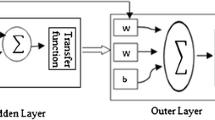Abstract
Ocean-colour remote sensing in optically shallow waters is influenced by contribution from the water column depth as well as by the substrate type. Therefore, it is required to include the contribution from the water column and substrate bottom type for bathymetry estimation. In this report we demonstrate the use of Artificial Neural Network (ANN) based approach to spectrally distinguish various benthic bottom types and estimate depth of substrate bottom simultaneously in optically shallow waters. We have used in-water radiative transfer simulation modeling to generate simulated top-of-the-water column reflectance the four major benthic bottom types viz. sea grass, coral sand, green algae and red algae using Hydrolight simulation model. The simulated remote sensing reflectance, for the four benthic bottom types having benthic bottom depth up to 30 m were generated for moderately clear waters. A multi-layer perceptron (MLP) type neural network was trained using the simulated data. ANN based approach was used for classification of the benthic bottom type and simultaneous inversion of bathymetry. Simulated data was inverted to yield benthic bottom type classification with an accuracy of ~98% for the four benthic substrate types and the substrate depth were estimated with an error of 0% for sea grass, 1% for coral sand and 1–3% for green and red algae up to 25 m, whereas for substrate bottom deeper than 25 m depth the classification errors increased by 2–5% for three substrate bottom types except sea grass bottom type. The initial results are promising which needs validation using the in-situ measured remote sensing reflectance spectra for implementing further on satellite data.



Similar content being viewed by others
References
Ackleson, S. G. (2003). Light in shallow waters: A brief research review. Limnology and Oceanography, 48(1), 323–328.
Barber, C. V. & Pratt, V. R. (1998). Poison and profit: Cyanide fishing in the Indo-Pacific. Environment, Heldref Publications.
Chauhan, P., Nagamani, P. V., & Nayak, S. R. (2005). Artificial neural networks (ANN) based algorithms for chloorphyll estimation in the Arabian Sea. Journal of Indian Society of Remote Sensing, 34(4), 368–373.
Dawson, M. S. & Fung, A. K. (1993). Neural Networks and their applications to parameter retrieval and classification. IEEE Geoscience and Remote Sensing Society Newsletter, pp. 6–14.
Fausett, L. (1994). Fundamentals of Neural networks; Architecture, algorithms and applications. New Jersey: Prentice Hall.
Hu, Y. H. & Hwang, J. N. (2002). Handbook of neural network signal processing.
IOCCG. (2000). Remote sensing of ocean colour in coastal, and other optically-complex, waters. In S. Sathyendranath (Ed.), Reports of the international ocean-colour coordinating group, no. 3. Dartmouth: IOCCG.
Lee, Z. P., Carder, K. L., Mobley, C. D., Steward, R. G., & Patch, J. S. (1998). Hyperspectral remote sensing for shallow waters: 1. A semi analytical model. Applied Optics, 37, 6329–6338.
Lee, Z. P., Carder, K. L., Mobley, C. D., Steward, R. G., & Patch, J. S. (1999). Hyperspectral remote sensing for shallow waters: 2. Deriving bottom depths and water properties by optimization. Applied Optics, 38, 3831–3843.
Lyzenga, D. R. (1978). Passive remote-sensing techniques for mapping water depth and bottom features. Applied Optics, 17, 379–383.
Lyzenga, D. R. (1981). Remote sensing of bottom reflectance and water attenuation parameters in shallow water using aircraft and Landsat data. International Journal of Remote Sensing, 2, 71–82.
Maritorena, S., Morel, A., & Gentili, B. (1994). Diifuse reflectance of oceanic shallow waters: Influence of the water depth and bottom albedo. Limnology and Oceanography, 39(7), 1689–1703.
Mobley, C. D. (1994). Light and water: Radiative transfer in natural waters (p. 592). San Diego: Academic.
Mobley, C. D., & Sundman, L. K. (Eds.). (2001). Hydrolight 4.2 user’s guide (p. 98052). WA: Sequoia Scinetific, Inc. Westpark Technical Center.
Mumby, P. J., Green, E. P., Clark, C. D., & Edwards, A. J. (1997). Coral reef habitat mapping: How much detail can remote sensing provide? Marine Biology, 130, 193–202.
Nagamani, P. V., Chauhan, P. & Dwivedi, R. M. (2007). Estimation of chlorophyll-a concentration using artificial neural network (ANN) based algorithm with Oceansat-1 OCM data, Journal of Indian Society of Remote Sensing.
Polcyn, F. C., Brown, W. L., & Sattinger, I. J. (1970). The measurement of water depth by remote sensing techniques, Report 8973-26-F. Ann Arbor: Willow Run Laboratories, The University of Michigan.
Rumelhart, D. E., & McClelland, J. L. (1986). Parallel distributed processing. Cambridge: MIT.
Serge, A., Hochberg, E.J., Chevillon, C., Muller-Karger, F.E., Brock, J.C. & Chuamin, H.U. (2005). Multi-scale remote sensing of coralreefs. In R. L. Miller et al., (eds.), Remote sensing of coastal aquatic environments (pp. 297–315).
Thiria, S., Mejia, C., Badran, F., & Crepon, M. (1993). A neural network approach for modeling non-linear transfer functions: Applications for wind retrieval from spaceborne scatterometer data. Journal of Geophysical Research, 98, 22,827–22,841.
Acknowledgement
This work is supported under MOP-II project at NRSC, Hyderabad and under the OCEANSAT-II utilization program at SAC, ISRO, Ahmedabad. The authors are thankful to Dr. V. Jayaraman, director, NRSC for his encouragement. We are grateful to Dr. R. R. Navalgund, Director, Space Applications Centre, (ISRO), Ahmedabad for taking keen interest in this work.
Author information
Authors and Affiliations
Corresponding author
About this article
Cite this article
Nagamani, P.V., Chauhan, P., Sanwlani, N. et al. Artificial Neural Network (ANN) Based Inversion of Benthic Substrate Bottom Type and Bathymetry in Optically Shallow Waters - Initial Model Results. J Indian Soc Remote Sens 40, 137–143 (2012). https://doi.org/10.1007/s12524-011-0142-y
Received:
Accepted:
Published:
Issue Date:
DOI: https://doi.org/10.1007/s12524-011-0142-y




